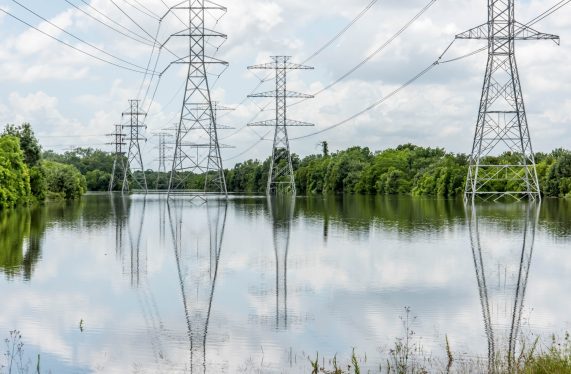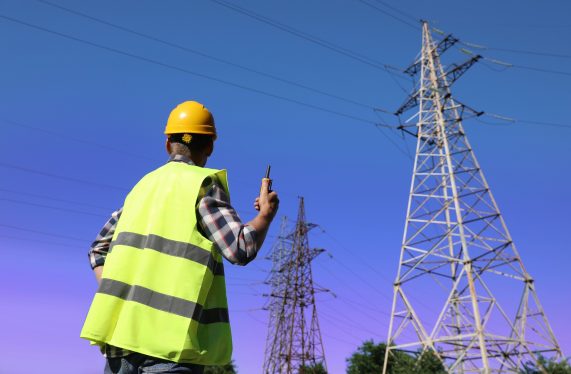The transmission of electricity is one of the most important infrastructures, since through it electrical current reaches the consumers (Cities, Industries, etc.).
This transmission is achieved through conductors (cables) either buried in the ground (underground) or on poles (overhead).
Today, the growing renewable energy installations in the country require the increase of the transmission capacity of the existing network. This presupposes its strengthening either through new networks or through upgrading existing ones.
The upgrading the existing transmission networks is carried out through upgrading the pipelines. Thus, the power-carrying capacity of the line to be upgraded is increased. ACCC technology conductors bring a different approach to the current problem as they are not bimetallic but rather their core is made of synthetic materials.
The ACCC conductor core was developed using aerospace-grade carbon and glass fibres and a high-performance, high-temperature resin system, so its extremely high strength and light weight allowed up to 30 percent more aluminium to be incorporated without a weight or diameter penalty which effectively reduces conductor resistance.
ACCC's reduced resistance lessens line losses by 25 to 40 percent or more compared to any other conductor of the same diameter and weight, depending on the load level.

To evaluate various types of pipelines, Ontario Hydro, a large Canadian utility company, performed a buckling test in a Kinectrics' laboratory.
Each conductor was placed at a span of 65 meters and a load of 1,600 amperes was applied. While the ACCC conductor showed the least thermal relaxation compared to the other conductors tested, it also ran much cooler under equal load conditions. The cooler operating temperature of the ACCC pipeline reflects reduced line losses as well as greater emergency reserve, which can further help improve grid reliability.
The reduced electrical resistance of the ACCC conductor compared to other conductors of the same diameter and weight not only offers a huge reduction in line losses, which translates into reduced fuel consumption and emissions, but also makes available the production capacity that would normally be required to support these losses.
For medium and long distance lines, the inductive reactance is more dominant than the conductor resistance. It should be noted that the core materials of some conductors are highly magnetic.
For example, Invar steel contains about 36% Ni, which makes it highly magnetic with a relative magnetic permeability approaching 6000m.5.
This greatly increases the internal inductance and total inductance (and inductive reactance) by at least two orders of magnitude, with significant effects on power quality, voltage drop as well as circuit stability (VAR consumption). The ACCC conductor core is non-metallic and non-magnetic and therefore offers significant advantages in lines of any length, voltage or current.
While ACCC offers utility companies a new conductor solution, the materials used to produce the ACCC core have been tested in many other demanding applications. Carbon fibre and glass hybrids, first introduced more than 30 years ago, are known not only for their high strength and light weight, but especially for their resistance to fatigue from cyclic loading, corrosion and collision.
Although applications in the automotive, aerospace and high-performance sports industries are common, composites are also widely used in offshore applications, infrastructure, medical applications, military applications, piping applications, power generation and storage applications (such as compressed natural gas tanks ), with excellent results.
While initial costs may be slightly higher, life cycle costs are significantly reduced and performance and longevity are greatly improved.
The performance characteristics offered by the ACCC composite conductor core are ideal for a bare overhead conductor application where environmental and operating conditions can be extremely harsh and highly cyclic and where temperature, stress, vibration and stress can affect lifespan. Environmental conditions usual on Greek territory.
More information about the ACCC pipeline can be found on the CTC global website:

Η ψυχρότερη θερμοκρασία λειτουργίας του αγωγού ACCC αντανακλά μειωμένες απώλειες γραμμής καθώς και μεγαλύτερη εφεδρεία έκτακτης ανάγκης, η οποία μπορεί να συμβάλει περαιτέρω στη βελτίωση της αξιοπιστίας του δικτύου.
Η μειωμένη ηλεκτρική αντίσταση του αγωγού ACCC σε σύγκριση με άλλους αγωγούς της ίδιας διαμέτρου και βάρους όχι μόνο προσφέρει τεράστια μείωση των απωλειών γραμμής, η οποία μεταφράζεται σε μειωμένη κατανάλωση καυσίμων και εκπομπές ρύπων, αλλά καθιστά επίσης διαθέσιμη την παραγωγική ικανότητα που κανονικά θα απαιτούνταν για την υποστήριξη αυτών των απωλειών.
Για γραμμές μεσαίων και μεγάλων αποστάσεων, η επαγωγική αντίδραση είναι πιο κυρίαρχη από την αντίσταση του αγωγού. Πρέπει να σημειωθεί ότι τα υλικά πυρήνα ορισμένων αγωγών είναι ιδιαίτερα μαγνητικά.
Για παράδειγμα, ο χάλυβας Invar περιέχει περίπου 36% Ni, γεγονός που τον καθιστά ιδιαίτερα μαγνητικό με σχετική μαγνητική διαπερατότητα που πλησιάζει τα 6000μ.
Αυτό αυξάνει σημαντικά την εσωτερική αυτεπαγωγή και τη συνολική αυτεπαγωγή (και την επαγωγική αντίδραση) κατά τουλάχιστον δύο τάξεις μεγέθους, με σημαντικές επιπτώσεις στην ποιότητα της ισχύος, στην πτώση τάσης καθώς και στη σταθερότητα του κυκλώματος (κατανάλωση VAR). Ο πυρήνας του αγωγού ACCC είναι μη μεταλλικός και μη μαγνητικός και συνεπώς προσφέρει σημαντικά πλεονεκτήματα σε γραμμές οποιουδήποτε μήκους, τάσης ή ρεύματος.
Ενώ το ACCC προσφέρει στις επιχειρήσεις κοινής ωφέλειας μια νέα λύση αγωγών, τα υλικά που χρησιμοποιούνται για την παραγωγή του πυρήνα ACCC έχουν δοκιμαστεί σε πολλές άλλες απαιτητικές εφαρμογές. Τα υβρίδια ινών άνθρακα και γυαλιού, τα οποία παρουσιάστηκαν για πρώτη φορά πριν από περισσότερα από 30 χρόνια, είναι γνωστά όχι μόνο για την υψηλή αντοχή και το μικρό βάρος τους, αλλά κυρίως για την αντοχή τους στην κόπωση από κυκλικά φορτία, τη διάβρωση και την κρούση.
Αν και οι εφαρμογές στην αυτοκινητοβιομηχανία, τα αεροσκάφη και τα αθλητικά είδη υψηλών επιδόσεων είναι συνηθισμένες, τα σύνθετα υλικά χρησιμοποιούνται επίσης ευρέως σε υπεράκτιες εφαρμογές, υποδομές, ιατρικές εφαρμογές, στρατιωτικές εφαρμογές, εφαρμογές σωληνώσεων, εφαρμογές παραγωγής ενέργειας και αποθήκευσης (όπως δεξαμενές συμπιεσμένου φυσικού αερίου), με εξαιρετικά αποτελέσματα. Ενώ το αρχικό κόστος μπορεί να είναι ελαφρώς υψηλότερο, το κόστος κύκλου ζωής μειώνεται σημαντικά και οι επιδόσεις και η μακροζωία βελτιώνονται σημαντικά.
Τα χαρακτηριστικά απόδοσης που προσφέρει ο σύνθετος πυρήνας του αγωγού ACCC είναι ιδανικά για την εφαρμογή ενός γυμνού εναέριου αγωγού, όπου οι περιβαλλοντικές συνθήκες και οι συνθήκες λειτουργίας μπορεί να είναι εξαιρετικά σκληρές και έντονα κυκλικές και όπου η θερμοκρασία, η τάση, οι κραδασμοί και η καταπόνηση μπορούν να επηρεάσουν τη διάρκεια ζωής. Περιβαλλοντικές συνθήκες συνήθεις επί της Ελληνικής επικράτειας.
Περισσότερες πληροφορίες σχετικά με τον αγωγό ACCC θα βρείτε στην ιστοσελίδα της CTC global:



